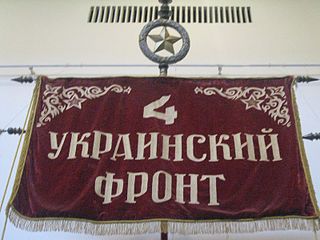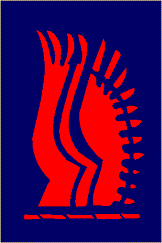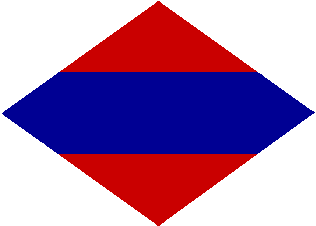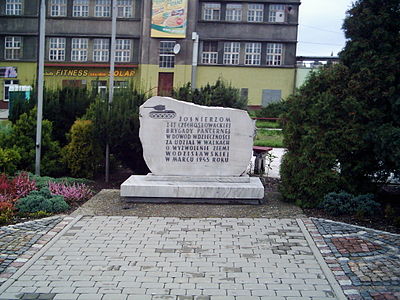
The 36th Infantry Division ("Arrowhead"), also known as the "Panther Division", "Lone Star Division", "The Texas Army", or the "T-patchers", is an infantry division of the United States Army and part of the Texas Army National Guard. It was organized during World War I from units of the Texas and Oklahoma National Guard. It was reactivated for service for World War II 25 November 1940, was sent to the European Theater of Operations in April 1943, and returned to the Texas Army National Guard in December 1945.

The XVIII Airborne Corps is a corps of the United States Army that has been in existence since 1942 and saw extensive service during World War II. The corps is designed for rapid deployment anywhere in the world and is referred to as "America's Contingency Corps". Its headquarters are at Fort Bragg, North Carolina.
The 1st Czechoslovak Independent Armoured Brigade Group was an armoured unit of expatriate Czechoslovaks organised and equipped by the United Kingdom during the Second World War in 1943.

The Polish II Corps, 1943–1947, was a major tactical and operational unit of the Polish Armed Forces in the West during World War II. It was commanded by Lieutenant General Władysław Anders and fought with distinction in the Italian Campaign, in particular at the Battle of Monte Cassino. By the end of 1945, the corps had grown to well over 100,000 soldiers.

The Polish First Army was an army unit of the Polish Armed Forces in the East formed in the Soviet Union in 1944, from the previously existing Polish I Corps in the Soviet Union, as part of the People's Army of Poland (LWP). The First Army fought westward, subordinated to the Soviet 1st Belorussian Front, during the offensive against Germany that led to the capture of Warsaw in January 1945, and the capture of Berlin in May 1945.

Ludvík Svoboda was a Czechoslovak general and politician. He fought in both World Wars, for which he was regarded as a national hero, and he later served as President of Czechoslovakia from 1968 to 1975.

The 35th Infantry Division, formerly known as the 35th Division, is an infantry formation of the Army National Guard at Fort Leavenworth.

The Battle of the Dukla Pass, also known as the Dukla / Carpatho-Dukla / Rzeszów-Dukla / Dukla-Prešov Offensive was the battle for control over the Dukla Pass on the border between Poland and Slovakia on the Eastern Front of World War II between Nazi Germany and the Soviet Union in September–October 1944. It was part of the Soviet East Carpathian Strategic Offensive that also included the Carpathian-Uzhgorod Offensive. The operation's primary goal, to provide support for the Slovak rebellion, was not achieved, but it concluded the full liberation of the Ukraine in its modern borders by the occupation of the Subcarpathian region as a territory of the former Carpatho-Ukraine.

The 4th Ukrainian Front was the name of two distinct Red Army strategic army groups that fought on the Eastern Front in World War II.

The 24th Infantry Brigade was an infantry brigade formation of the British Army from the First World War, serving through the Second World War, until 1999 when it was merged with the 5th Airborne Brigade to form 16 Air Assault Brigade.

The 10th Indian Infantry Division was a war formed infantry division of the Indian Army during World War II. In four years, the division travelled over 4,000 miles (6,400 km) from Tehran to Trieste, fought three small wars, and fought two great campaigns: the Anglo-Iraqi War, the Invasion of Syria-Lebanon, the Anglo-Soviet invasion of Iran, the North African Campaign, and the Italian Campaign.

Rudolf Viest was a Slovak military leader, member of the Czechoslovak government in exile, member of the Slovak National Council and the commander of the 1st Czechoslovak army during the Slovak National Uprising. He was the Slovak with the highest military function and the only Slovak general during the interwar period in the first Czechoslovak Republic.

The Central Group of Forces was a formation of the Soviet Armed Forces used to incorporate Soviet troops in Central Europe on two occasions: in Austria and Hungary from 1945-55 and troops stationed in Czechoslovakia after the Prague Spring of 1968.
The Czechoslovak Legion was a military unit formed in the Second Polish Republic after Germany occupied Czechoslovakia in March 1939. The unit took symbolic part in the defence of Poland during the German invasion on 1 September 1939.

The Siege of Dunkirk, also known as the Second Battle of Dunkirk, during the Second World War, occurred from September 1944, when units of the Second Canadian Division surrounded the fortified city and port of Dunkirk. The siege by Allied forces lasted until after the official end of the war in Europe. German units within the fortress withstood probing attacks and as the opening of the port of Antwerp was more important, the 21st Army Group commander, Field Marshal Bernard Montgomery, decided to mask Dunkirk with the 1st Czechoslovak Armoured Brigade. The fortress, commanded by Admiral Friedrich Frisius, eventually surrendered unconditionally to Brigádní generál Alois Liška, the commander of the Czechoslovak brigade group, on 9 May 1945, two days after the surrender of Nazi Germany.

The Battle of Sokolovo took place on 8 and 9 March 1943, near the town of Sokolovo near Kharkiv in Ukraine when the ongoing attack of the Wehrmacht was delayed by joint Soviet and Czechoslovak forces. It was the first time that a foreign military unit, the First Czechoslovak Independent Field Battalion, fought together with the Red Army. Under the command of Ludvík Svoboda, later President of Czechoslovakia, the Czechoslovak soldiers delayed the advance of Germans to the Mzha river. On 13 March the position was abandoned as untenable due to the complete German encirclement of Kharkov.

The First Canadian Army was a field army and a formation of the British Army in which most Canadian elements of the British Army serving in Northwest Europe were assigned. During the Second World War it served on the Western Front from July 1944 until May 1945.

Karel Klapálek, CBE, DSO was a Czechoslovak Army general and a veteran of the Czechoslovak Legion in the Russian Empire. He fought in both World Wars and was decorated with numerous national honours.
The 83rd Rifle Division was an infantry division of the Red Army during World War II.
The 13th Tank Division was an armored division of the Czechoslovak People's Army during the Cold War that became part of the Army of the Slovak Republic after the Dissolution of Czechoslovakia.


















